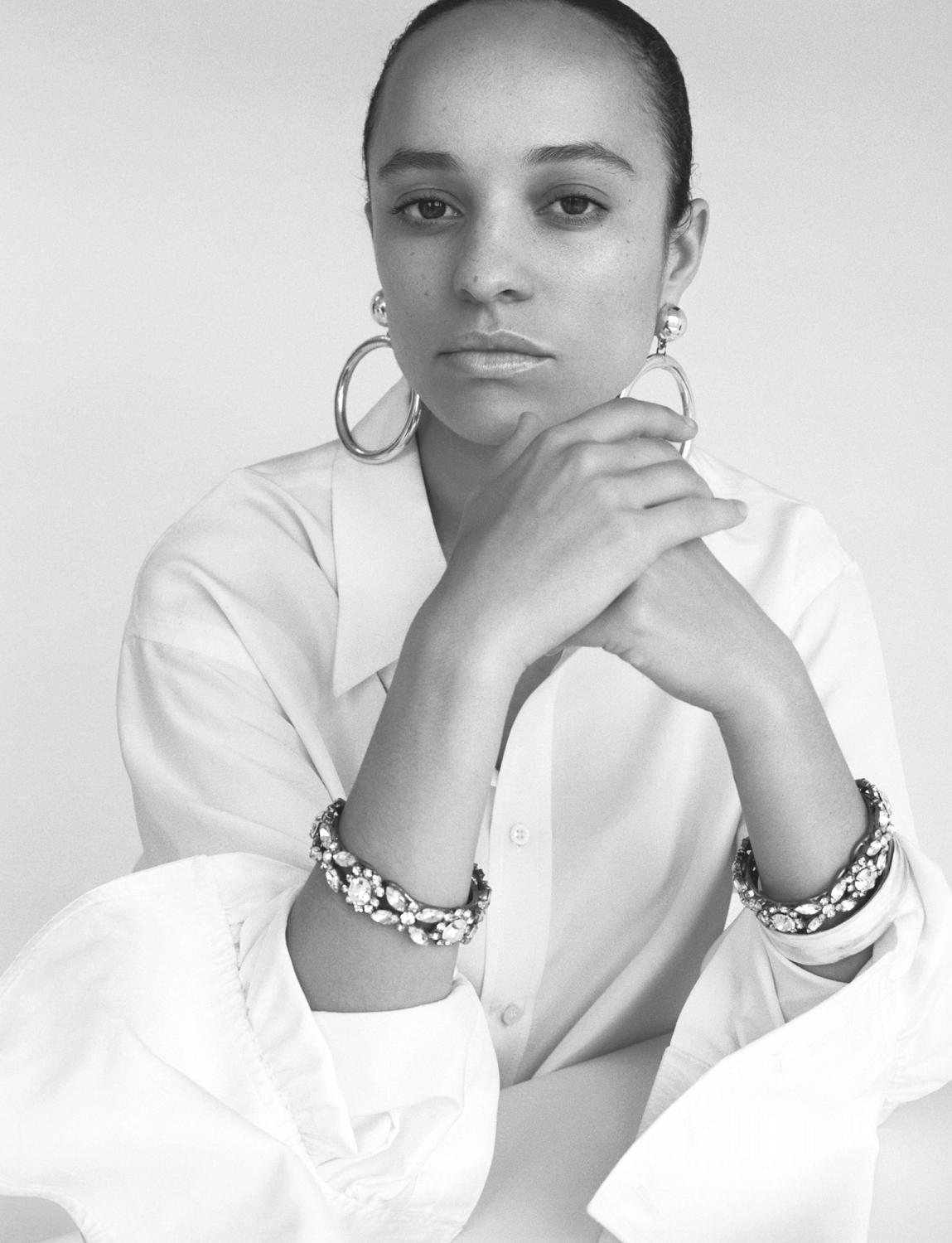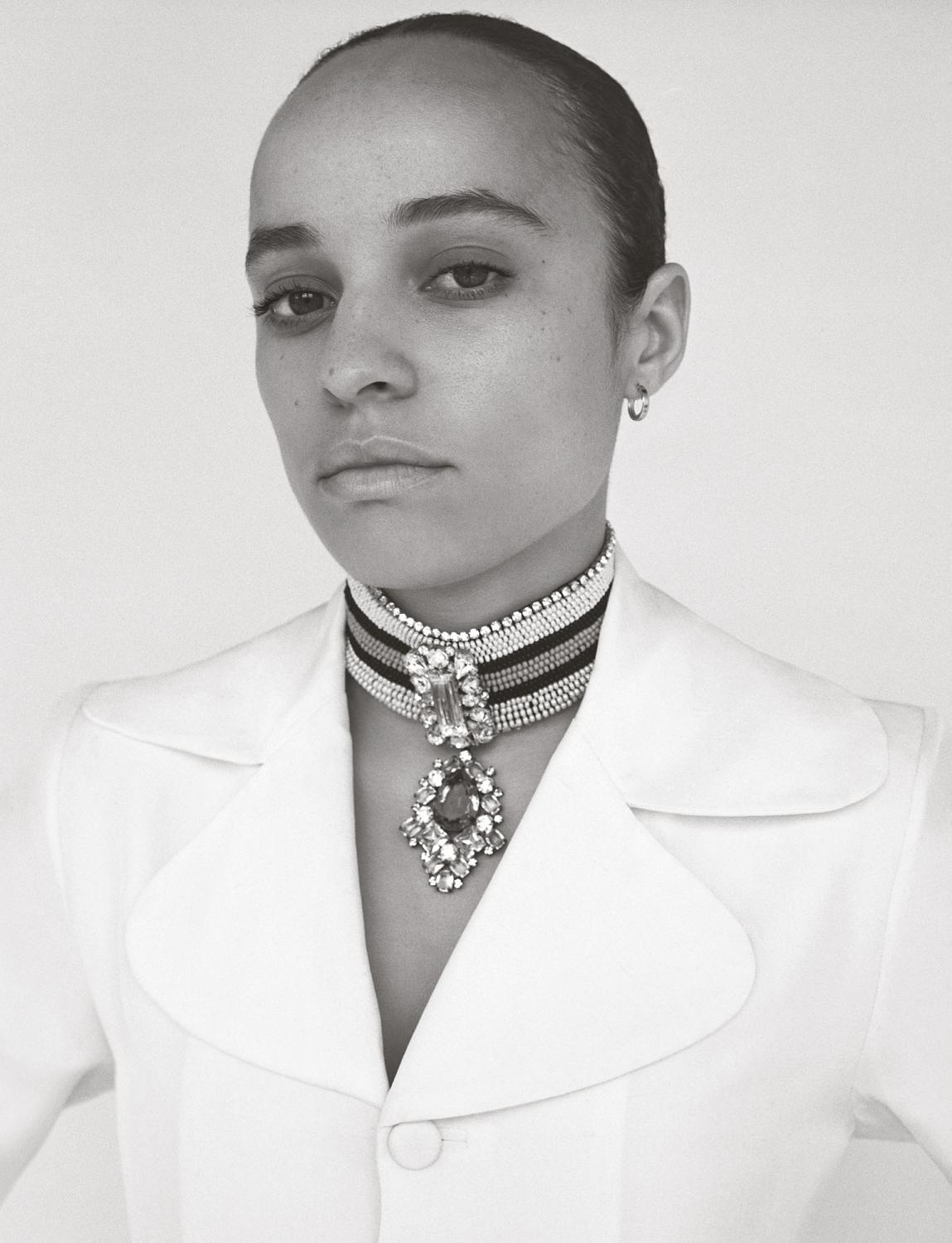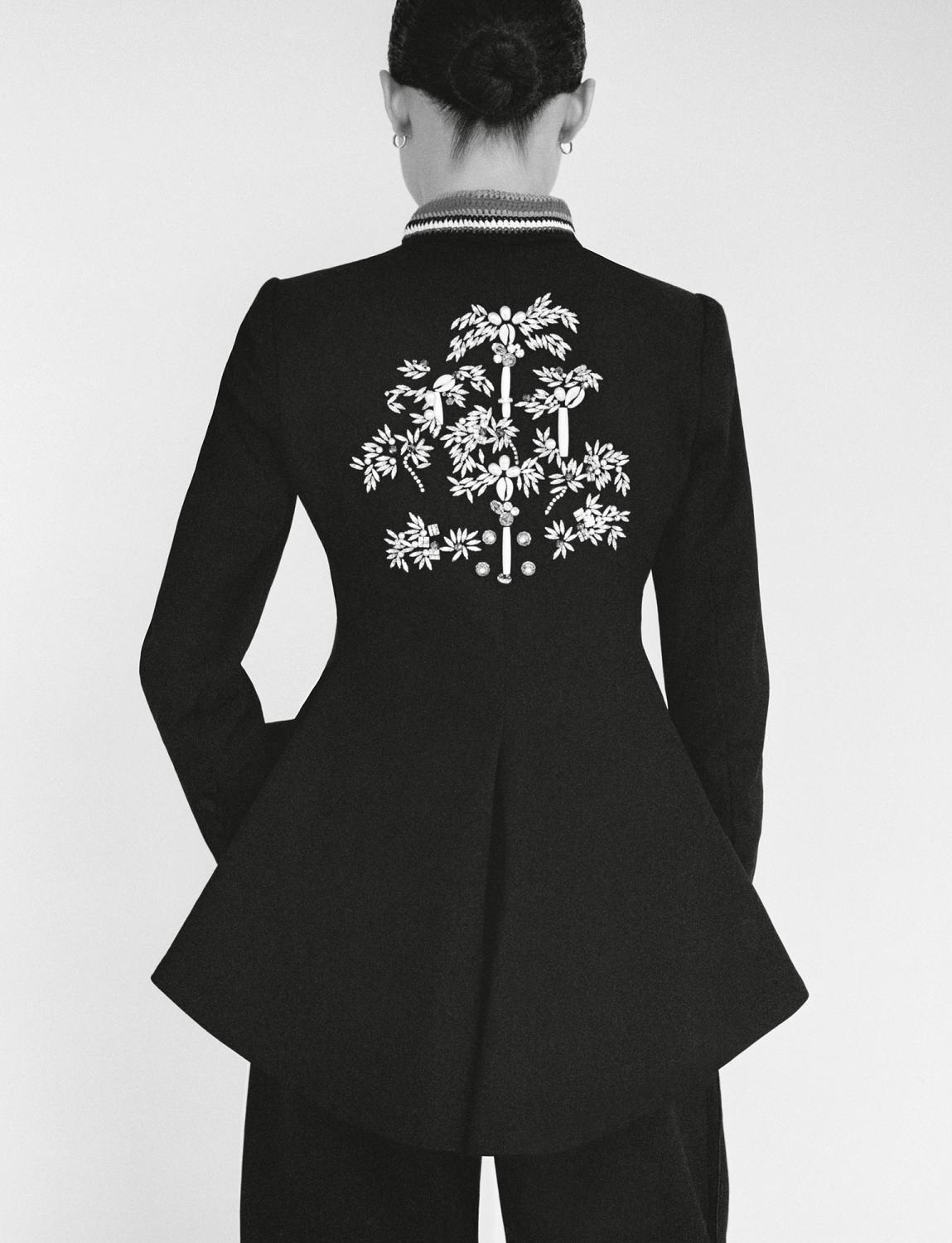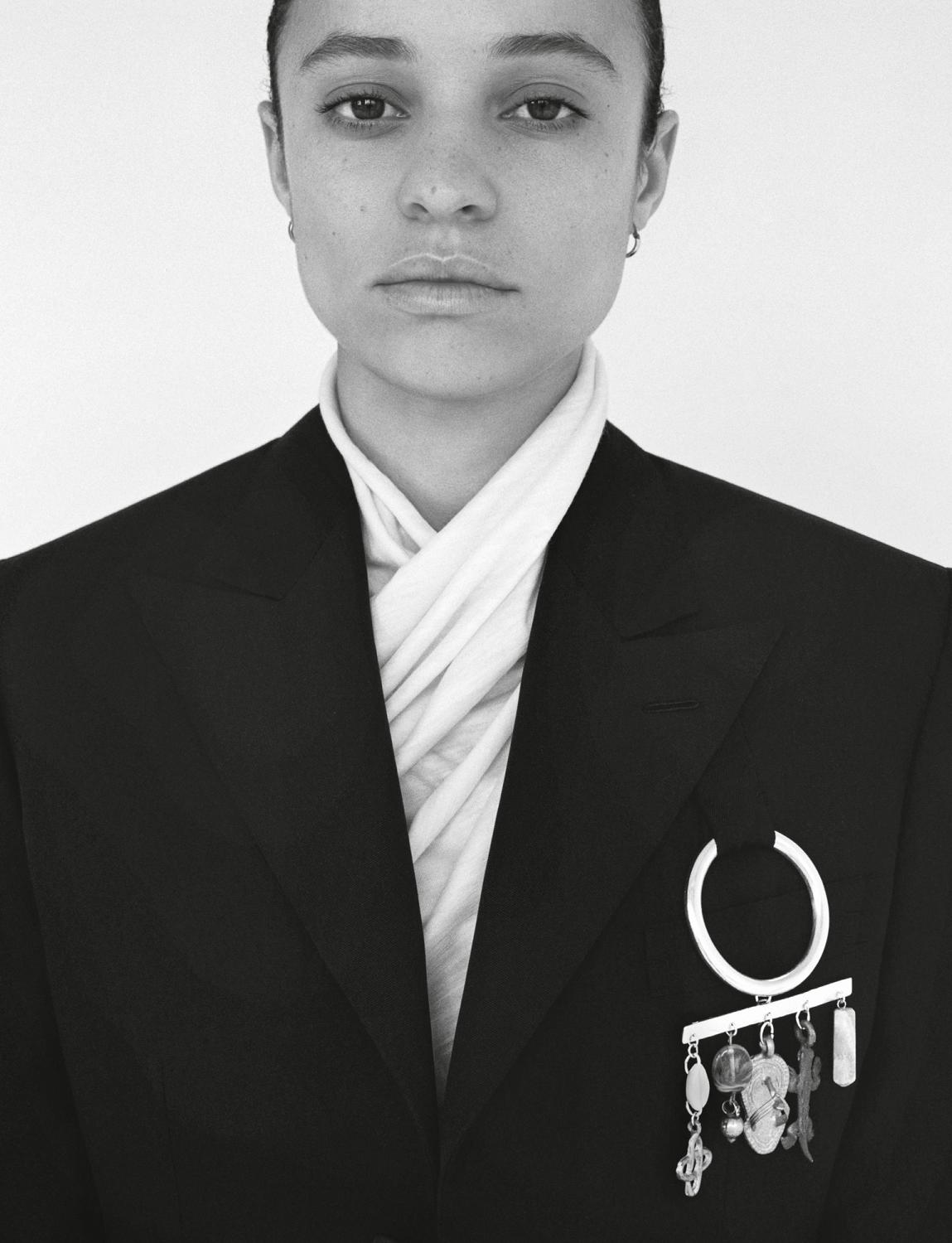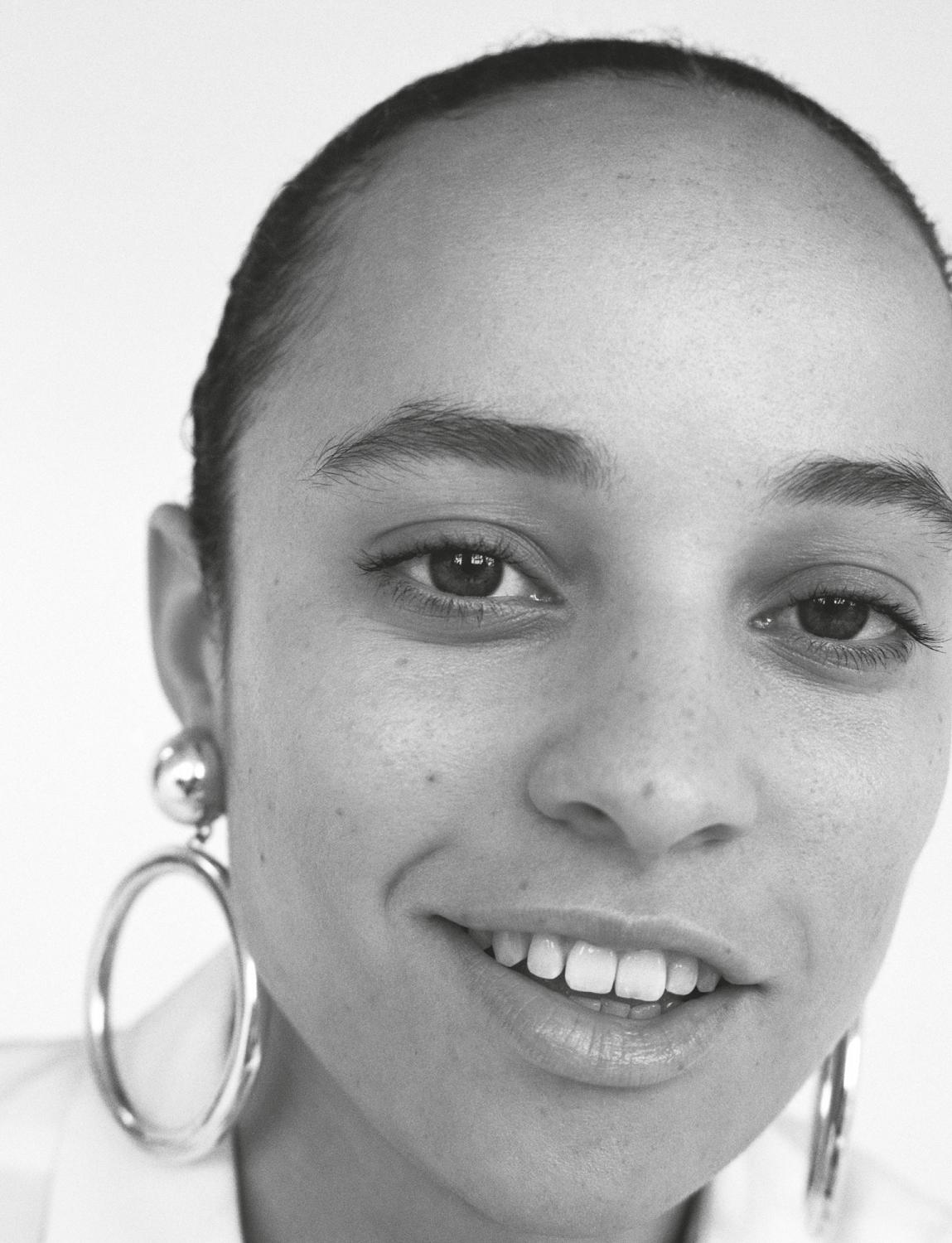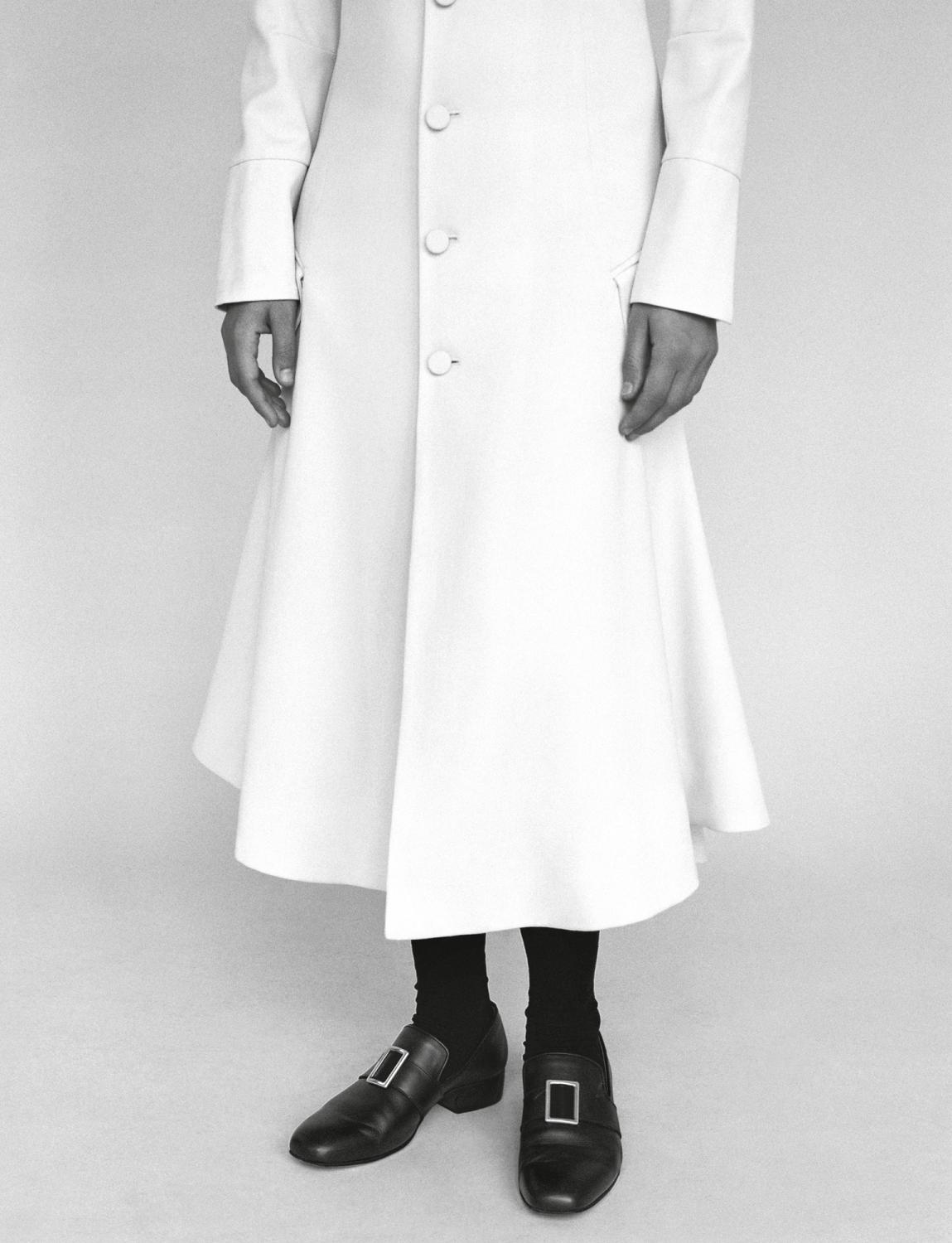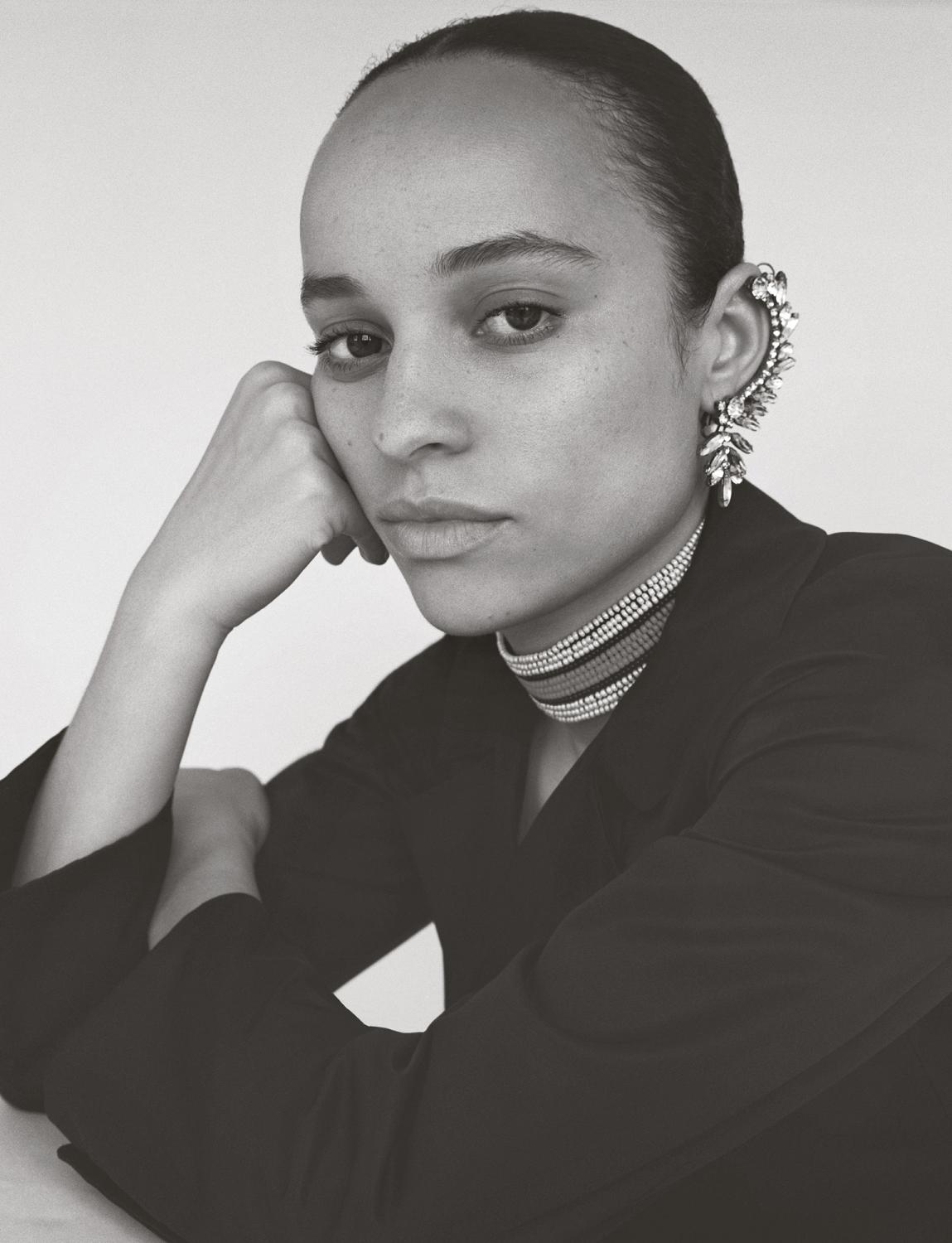The Wardrobe with Grace Wales Bonner
Here, Grace wears a Florence white silk shantung shirt with double cuffs from her Autumn/Winter 2016–17 WALES BONNER collection. The silver Sphere earrings are from her Spring/Summer 2017 collection, and the Swarovski crystal Sun bracelets and Emory horn bracelets are from A/W 2016.
The wide-lapelled Baba shirt in ivory silk shantung on this page is from WALES BONNER A/W 2016, as is the Oryema beaded choker. The earrings are Grace’s own.
“How I live is about respect. I want people around me to be healthy and take themselves seriously.”
The Cane frock jacket in black wool with Swarovski crystals and beading was modelled by Alice Dellal in the S/S 2017 WALES BONNER show. Grace wears it with black mohair tuxedo trousers from the same collection. The earrings are Grace’s own.
On the left, she's in a total S/S 2017 WALES BONNER look: black mohair Alfred blazer over an ivory silk jersey sash-wrap shirt, finished with a silver Mowa medal. The earrings are Grace’s own. On the right, Grace wears the white silk shantung Florence shirt from A/W 2016 with the silver Sphere earrings from S/S 2017.
The Cane frock coat comes in ivory cashmere, the silver-buckled boots in black leather. They are both from WALES BONNER S/S 2017.
A Swarovski crystal Sun ear cuff and a beaded choker from A/W 2016 are the kind of handcrafted, mildly ritualistic touches that give edge to signature WALES BONNER suiting, like this double-breasted wool jacket from the S/S 2017 collection.
“I’m not targeting youth. A lot of my customers are over 40, and that feels like more of an achievement.”
Designing for women was never Grace Wales Bonner’s intention, yet there’s no shortage of female customers wanting to wear the impeccably glamorous tailoring the 25-year-old Londoner creates for men. Photographed in a selection of pieces from her past two Wales Bonner collections, Grace presents an irresistible new proposition for women’s fashion.
Talent comes in many forms in fashion, but there is no one who comes across Grace Wales Bonner and doesn’t quickly realise they’re dealing with a 25-year-old who is out of the ordinary. Something about the calm, self-aware way she’s stepped into the picture, designing menswear that could easily be womenswear and putting forward a whole new viewpoint on black identity, has an almost charismatic effect on people around her. She’s a preternaturally articulate member of a millennial generation that’s negotiating the world of work in an entirely new way. Her clothes express balance too, in a manner that’s fresh but simultaneously classic: they’re a fascinating fusion of political meaning – how long has meaning been absent from fashion? – and pragmatic wearability.
Perhaps it’s the fact that Grace is a Londoner with Jamaican and English heritage, and a young woman designer representing black men in ways that are almost diametrically opposite to the style of rap culture that has swivelled so many critics’ eyes in her direction. I count myself among them. The modest collections she’s produced under the company name Wales Bonner since graduating with a BA from Central Saint Martins in 2014 show an approach and perspective profoundly different from those of the other young designers I’ve seen coming out of the college in the last quarter century.
I speak to Grace a month after she’s won the €300,000 LVMH Prize for Young Fashion Designers in June. The prestigious award set up by Bernard Arnault’s luxury conglomerate is regarded in the industry as a seedbed for talent to supply the company’s major houses, which include Dior, Givenchy and Louis Vuitton. The prize came a couple of weeks after her first solo show, Ezekiel, in London men’s fashion week. The Spring/Summer 2017 collection was inspired by the court of Emperor Haile Selassie of Ethiopia, with impeccably formal tailcoats, suits, capes, and one coat emblazoned with pearl, cowrie shell and bone beading on the back. “It had ceremonial aspects mixed with a Caribbean element. I wanted something formal, restrained, elegant and pure,” Grace says. It certainly hit the mark. The show’s producer, Sam Gainsbury – never an easy woman to impress – came up to me afterwards and said, “Let’s face it, that’s what you and I would wear. We were all saying we want it, backstage.”
The reaction wasn’t triggered by anything as straightforward as the fact that the show gave Grace’s audience the first glimpse of Wales Bonner clothes on women – her customers were already female as well as male. “I’ve had a few female private clients asking for things since my graduate collection,” Grace says. The spring collection featured a black satin double-breasted coatdress with a gently flared volume, the hem dipping longer at the back, which was worn with a high-necked ivory shirt, as well as a black skirt suit with more embroidery on the front, both shown on female models. “I’ve been working with a tailor,” she says. “My taste is very classic and traditional. I’m interested in working in an old-school way.”
These pieces read as a discreet extension of what Grace had already been doing: tailoring and sweaters that were being bought by men and women alike. Last year I walked into Opening Ceremony in New York to see the Wales Bonner Autumn/Winter 2015–16 collection of purplish crushed velvet collarless jackets and elongated, high-waisted flares standing high on a podium between the women’s and men’s sections of the store. There were echoes of Chanel bouclé jackets, perhaps an influence of the 1970s. The pieces spoke to the kind of people who will leap at quality and originality in a garment before they will quibble over its supposed gender assignment. “Buyers get it,” she says. “But I love it when a boy puts on one of the embroidered jackets that the women wore and doesn’t know the difference – my work is about being open to interpretation.”
The clothes are the product of painstaking historical research and a set of personal values that run deep. “I’ve written down what I want the values of Wales Bonner to be and how I want to live,” Grace says. “I think it’s about respect. I want people around me to be healthy and to take themselves seriously.” She describes the summer holiday she’s about to go off on – and it’s not to whoop it up in Ibiza. “I’ve been invited to the Josef [& Anni] Albers Foundation in Senegal. It’s a place for artists, a kind of retreat where you’re encouraged to work with local craftspeople. I want to collaborate with graphic artists and people who make record covers. But you could equally well just sit, read and think. There’s no prescription.” Her eyes sparkle. “And then we’re going to drive upcountry. I don’t really know what the roads are going to be like. But it’s going to be way away from any phone and internet connection. I’m looking forward to that.”
Grace says she gets through the stress of making her collections by meditating every day and eating properly. “When there’s so much pressure, it’s easy to melt down,” she says. “But I manage to get up and meditate for maybe five, 20 minutes. By about seven, I’m happy and calm; you’ve taken control of your life.” There’s an almost therapeutic video on her website, shot on the shore of Lake Bosomtwe in Ghana. You see a fisherman casting his net, hear birds calling, and that’s it: nothing else. “We just put the camera there and left it running. It’s an incredibly serene place.” Without a single branded product in view, that calm-inducing footage suggests a lot about Grace and how she will shoulder the increasing demands placed upon her.
Once you start talking to her, it’s remarkable to see how – even at this early stage in her career – her mind isn’t just set on conveying concept and message in a flurry of recent-graduate enthusiasm. Her focus is on the emotional response to her clothes – not necessarily to their appearance but from the inside out. After the Ezekiel show in June, she was thrilled to hear her male models – mainly friends and boys she street-casts – saying they “felt like kings”. When she discusses the garments, it’s along the lines of how things feel. She talks of fabric being “kind” and of how she wants the shoulders of a jacket to empower the wearer. Technically, she’s tackling something that it’s impossible to be sketchy about. The disciplines are precise, and the processes cost money to produce properly. “I’m not targeting youth,” she says. “A lot of my customers are over 40, and that feels like more of an achievement.”
Wales Bonner is in the singular position where the demand for her work is anticipating its supply. Grace never set out to create womenswear, yet women are clamouring for her menswear. Ruth Chapman of the online retailer Matchesfashion.com called me after seeing the 2015 Wales Bonner presentation Fashion in Motion at London’s Victoria and Albert Museum, where Grace showed her collection as a chamber choir sang. “It was beautiful, incredibly moving,” Chapman said, and she promptly ordered items from the Harlem Renaissance-inspired Ebonics autumn collection – to sell as womenswear. “We were really drawn to the feminine pieces,” Chapman says. “It didn’t look specifically like menswear. But we did feel it was important to resize it for women so the fits were right, which Grace was very open toryAfter the LVMH prize-giving ceremony, Phoebe Philo, who had been on the panel of judges with Karl Lagerfeld, Nicolas Ghesquière, Jonathan Anderson, Riccardo Tisci, Humberto Leon and Carole Lim, stayed around to enthuse about Wales Bonner. “We saw how she could so easily extend into womenswear,” Philo said. Women are free to buy Wales Bonner’s men’s designs from boutiques such as Dover Street Market in London, New York and Ginza, and Joyce in Hong Kong, and online at Matchesfashion.com and Ssense.com, but no designated women’s line is yet planned. “It gives me confidence when I see women I respect wearing Wales Bonner,” Grace says. “But I don’t see the men’s and women’s separately for now. It will be a natural progression – I don’t want to put too much pressure on the business to evolve inorganically.”
Grace is the middle child of an achieving family, brought up in south London between her mother’s house in Dulwich and her father’s in Stockwell, after her parents separated. She excelled at school. Her elder sister went to Cambridge. “My father definitely drilled it into us that education was the way. He was born in London, the youngest of a family who’d come from Jamaica in the Windrush Generation.” She says everyone was “like her” at junior school, and she was only pointed out as being black by other kids when she went to secondary school, “which was odd, because when I went to Jamaica wi dad, we heard people saying, ‘Look, there go white people!’
By the time she began her degree at Central Saint Martins in 2009, she’d developed an academic interest in investigating black culture. Her dissertation looked at “black rhythmicality” in the work of the artists Charlie Parker, Jean-Michel Basquiat and Kerry James Marshall, and at how they brought African tradition to working within western art forms.
“And that,” she concludes, “is how I position myself. I’m working within an established form of representation. I like playing within parameters.”
Sarah MowerThe respected fashion critic and columnist Sarah Mower is always in the right place at the right time, which is a fortunate for the British Fashion Council, given her role as their Ambassador for Emerging Talent. A champion of designers such as JW Anderson, Christopher Kane and Simone Rocha, Sarah is…read more Photography by
Angelo PennettaAngelo Pennetta modestly describes his stellar career in fashion photography as entirely accidental. During a gap year travelling around Thailand, he decided to shelve plans to study business studies and Italian and instead enrolled on the BA Fashion Photography course at the London College of Fashion.…read more Styling by
Jonathan KayeJonathan Kaye is fashion director of The Gentlewoman. A graduate of Central St. Martins' prestigious MA Fashion course (the good ones often are), Jonathan is one of the most industrious stylists in the business and thus operates on a “strictly no parties” basis. He has collaborated with photographers…read more
Hair: Alex Brownsell at Streeters. Make-up: Lotten Holmqvist at Julian Watson Agency. Tailor: Ian Hundley. Photographic assistance: Rob Willey. Styling assistance: Max Ortega Govela.
This profile was originally published in The Gentlewoman n° 14, Autumn & Winter 2016.